I fell while hiking down a small mountain last week. I was fairly seriously injured, stranded in an area with no cell coverage, and ended up needing an EMS rescue to get me to the hospital. After cogitating about the incident for a week, I have some lessons learned to share so that the rest of you don’t end up in the spot I was in.
What Happened
I was hiking at the Balcones Canyonlands National Wildlife Refuge. I hike there about once a week. There are two trail loops I use. One is basically straight up and down the highest hill (or small mountain) in the area. It takes about an hour to complete. The second has some additional time walking around the top of the mountain and takes about an hour and forty-five minutes. I was doing the short loop last week when I fell. I was using the up and down trail to go fast and get some cardiovascular exercise as a workout. It wasn’t a leisurely stroll.
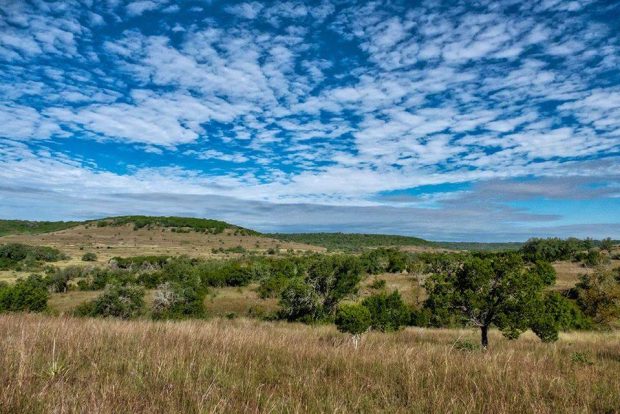
The trailhead looking out towards the park’s biggest hill
I had hiked up the mountain and was just starting the descent. Coming down the trail from the top of the mountain, I slipped on a loose rock and fell. I felt a huge pop in my left knee and a massive amount of pain.
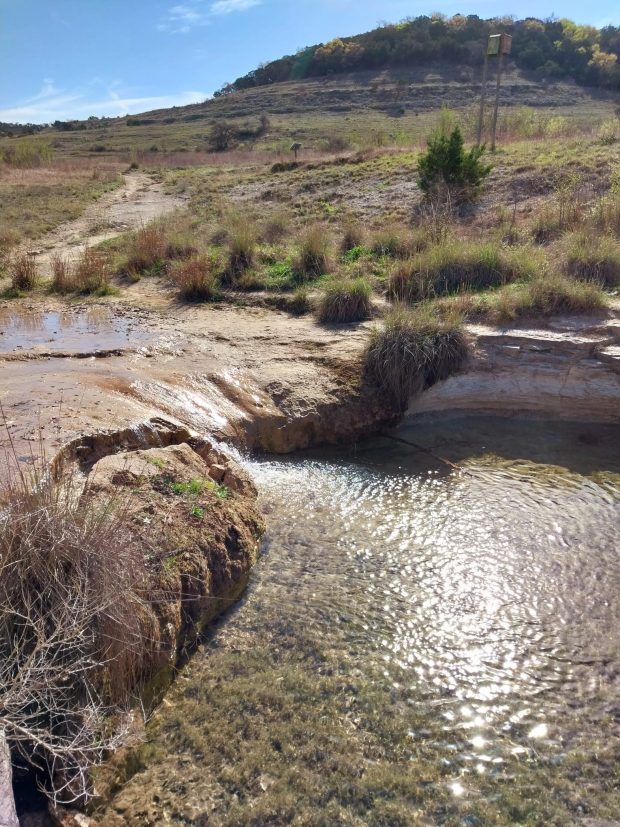
The view from the bottom of the mountain to the top. I fell in the wooded area near the top while on my way back down. It’s a little over a mile hike to get from this point to the top.
I was alone. No one else was hiking in the area and I had no cell service. I couldn’t bend my knee at all. When the knee was straight, pain was 3/10 but instantly went to 10/10 when I bent it.
I used a couple of scrub trees to stand and used my hiking pole to slowly work my way down the mountain. I fell a few more times and got to a point where I couldn’t stand up again.
I ended up crawling and sliding on my butt down the mountain. It took an hour and 40 minutes of that crawling/sliding before I got to a place with cell service and could call 911. Of course it was 105 degrees and I was sliding through poison oak, thorn bushes, and burning hot rocks. Luckily the rattlesnakes and scorpions left me alone.
I slid down to about a half mile from the trailhead and the medics were able to get to me. The trail was too narrow and I was too heavy for the medics to carry me out on a litter. We splinted my leg and they helped me hobble the rest of the way out.
I got a nice dose of fentanyl for the ride to the hospital. The ER doc did X-rays and found no broken bones. He guessed that I have a torn ACL, torn meniscus, and torn quadriceps muscle. They gave me a knee brace, some crutches, a morphine script and orders to set up an orthopedic appointment and MRI next week.
Initial Thoughts After I Fell
My knee was in bad shape. I had never hurt a knee this badly before despite a lifetime of contact sports, heavy weightlifting, and martial arts. I knew it was bad. I couldn’t move the knee without excruciating pain, but I thought if I could stand, the pain might lessen. I grabbed a couple of nearby cedar (what they call Juniper down here) trees and pulled myself to a standing position.
With the leg completely straight, it hurt much less. I decided to slowly walk down the mountain.
I made it a few hundred yards. During that time, my knee collapsed three times, dropping me to the ground over and over again. The last time I fell, there were no trees around me and I couldn’t pull myself up again. I had to take stock of my situation. I was prepared for a one-hour hike. I didn’t have much.
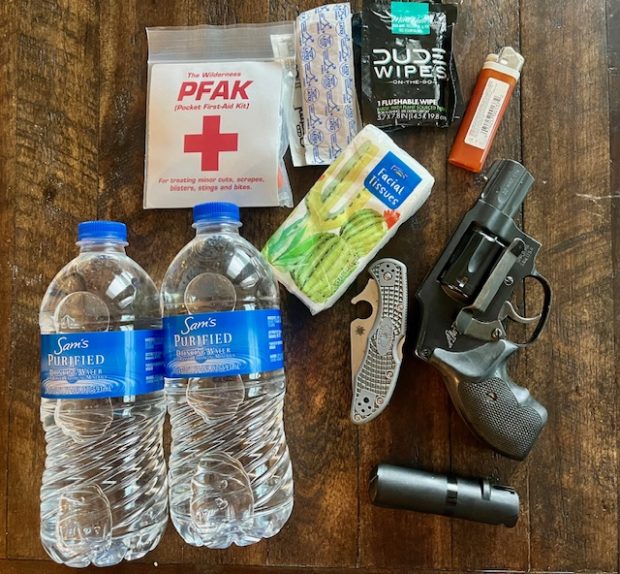
The gear I had with me
I was wearing shorts, a T-shirt, and hiking boots. I had an Osprey Sling pack that contained some water, a couple wet wipes, a pocket first aid kit from The Wilderness (thanks Sam!), a few extra band aids and alcohol wipes, some tissues, and a cigarette lighter.
I had a Smith and Wesson 351C .22 magnum revolver with no spare ammunition. In my pockets I had a Spyderco Delica knife, the Ka-Bar LDK knife that I designed, a can of POM pepper spray and a bandanna. I also had my iPhone 13 (with about 75% charge remaining) and a fully charged RovyVon keychain flashlight. I was carrying a single trekking pole.
It was mid afternoon. Over 100 degrees and bright sun without a cloud in the sky. Although there were two cars at the trailhead parking lot, I hadn’t seen a single hiker on the trail. I yelled out a few times, but got no response. My phone had no cell signal. I was about a mile from the trailhead. I was unable to stand. Unlike me, smart people in Texas don’t usually hike in the afternoon heat. There was a good chance I’d have to wait until morning before any other hikers passed by my location on the trail.
I had been listening to a podcast on my earbuds. I turned off the audio and switched my phone to airplane mode to conserve the battery until I could descend to an area with cell coverage.
The Injury and Medical Assessment
While I undoubtedly had some structural damage to the knee joint itself, I think the torn quad muscle was causing most of my pain and dysfunction. I couldn’t straighten my leg under its own power. Flexing the quad to extend the lower leg wasn’t possible, but I could physically move it into a straight position using my hands. The pain was 100X more manageable when the leg was straight.
I needed to splint the leg in a straight position to reduce pain, but I didn’t have any splinting material. I thought about cutting my shirt into strips and using those strips to improvise a splint using my trekking pole and/or a couple of tree branches. I decided against that because if I was going to be out there in the woods for a significant time period, I would probably need the shirt more for sun and insect protection than as an improvised splint.
I did not hit my head or lose consciousness during the fall. In addition to the knee injury, I severely strained a bicep muscle trying to grab a tree to arrest my descent. I had some gnarly painful “road rash” kind of abrasions on the calf of my good leg. I also had a minor bleeding laceration on my left forearm. I crawled to some shade and took a sip of water. I cleaned out the calf abrasions and the forearm cut with wet wipes as I contemplated the next step. I loosened the laces of my hiking boot on the injured side in the event swelling could make the boot more difficult to remove at some time in the future.
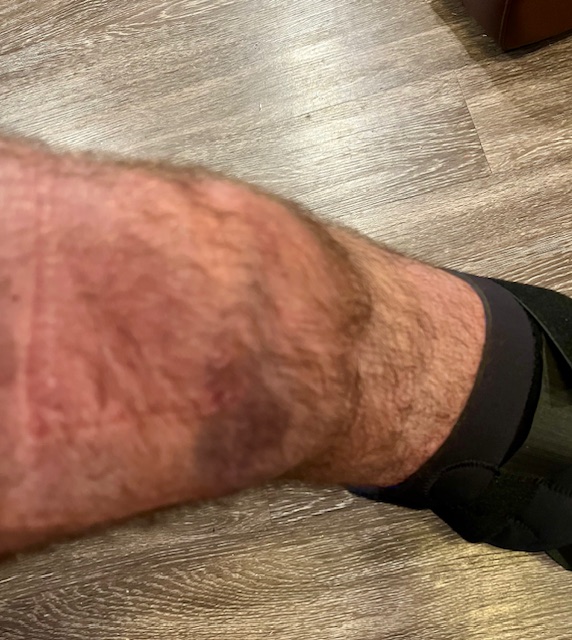
The first picture of my swollen knee after I took off the brace when I was home from the hospital.
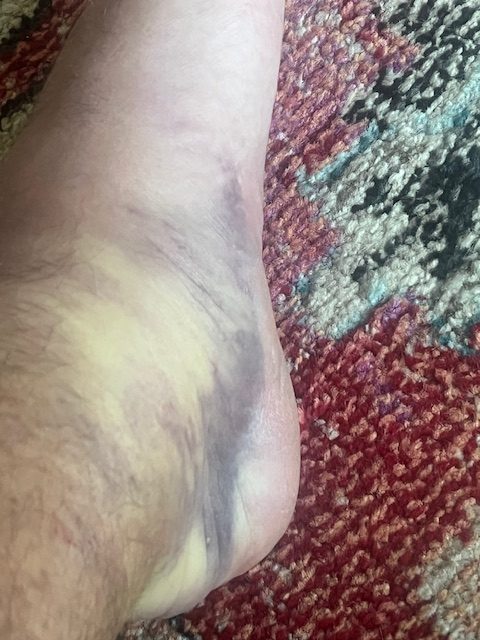
Downstream swelling and bruising on my ankle/foot from the knee injury.
I started to crawl out.
The Crawl/Slide
I decided that although I could survive the night in the woods, that course of action would be far more unpleasant than crawling/sliding down the hill towards the trailhead. I am biased towards action. I’d rather do something active than just place my fate in the hands of a random passerby. Having carried injured patients and dead bodies both in real life and in medical training classes, I knew that my rescue would be an absolute nightmare given the steep terrain and the rocky, unstable, narrow trail. If my rescuers dropped me on this trail, I’d probably be at risk for a greater injury than if I crawled myself out.
I crawled/slid for exactly one hour and 40 minutes (as tracked by my heart rate monitor) until I reached a spot where my phone began working again. I’m not going to lie. It sucked. But I knew I could do it.
How did I know? I‘ve written before about the value of doing hard things. As I was crawling down the mountain, I was reminded that I had once completed a long monitored “stalk” in a police sniper school. That particular class was during a particularly hot and humid Ohio summer. The instructors dropped us off more than a half mile away from our “target.” We were required to low crawl through an overgrown field full of thorny raspberry and rose bushes undetected.
The objective was to sneak undetected to within 100 meters of the target and fire the shot without being seen by the instructors who were walking through the same field and watching for us using binoculars. The suck factor was high, but I successfully completed the exercise.
As I was crawling through the underbrush, I kept mentally telling myself “This is the same thing you did in sniper school. You survived that and you will survive this too.” Having previously completed a similar physical feat gave me the mental strength to keep going last week.
The Rescue
It took nearly an hour after the 911 call before the first rescuers arrived at my location. The first two people who reached me were young EMTs from the local volunteer fire department. They worked hard to get to me as fast as they could, but they just had a small aid bag and some water. It took about 10 more minutes before two more rescuers (one a paramedic) arrived with a litter to carry me down.
There was no way that the four folks they sent would have been able to carry my 275-pound carcass down that treacherous trail. They were willing to try, but I didn’t want them to get hurt as well. There was no nearby place for a helicopter landing. The medics were talking about calling a specialized medical chopper with a litter that they could lower via a cable while the helicopter hovered. That seemed like a bit of overkill given the fact that I was not in life threatening danger.
I convinced the medics that if they could splint my leg and give me some assistance walking, I could hobble my way out. They agreed to try.
The EMTs pulled out two SAM splints, but didn’t know how to apply them properly to my particular injury. I ended up showing them how to optimally configure the splint to keep my leg as straight as possible. As a quick side note, if you carry SAM splints, watch the free videos on their website to learn all the innovative ways to utilize this handy piece of equipment.
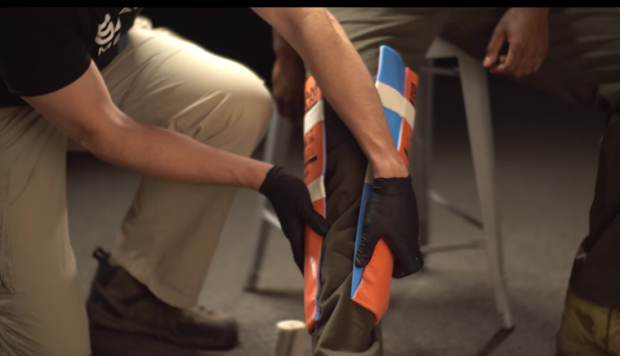
SAM splints
Physical fitness plays a role in your ability to rescue yourself as well. The medics confided in me that they were really worried when they got the call of a man in his 50s who had fallen and couldn’t get up. Given their past experiences with rescues on this trail, they told me that they expected some frail dude with a broken hip or suffering from a heart attack. They anticipated that the rescue would be difficult and that the patient would offer no assistance.
They were actually delighted when they found a dude who was willing and able to work with them to assist with his own rescue. One medic told me “If there was a Yelp review for patients, I’d give you five stars!” If I hadn’t been as strong and as fit as I am, the medics would have had to carry me. Being dropped out of a litter would have been a really bad outcome. Work to be able to assist with your own rescue.
What I will change
While everything turned out OK, there was a potential for things to have been much worse. Here’s the additional things I’m going to do moving forward to help minimize the negative consequences should I suffer a similar emergency.
Carry some manner of communications that doesn’t rely on cell signals. I’m a bit of a tech Luddite. Friends have recommended the following solutions.
Upgraded iPhone with satellite communications ability
I will explore those options and have something in place for future solo hikes.
Carry more water. I had two 20 oz. water bottles for my hour hike. That would have been fine for an hour, but it wasn’t enough for four hours during a 100+ degree day.
Wear light colored clothing. I was wearing a white T-shirt. That’s what the rescuers said they saw first and it allowed them to find me quicker. If I had been unconscious, wearing bright clothing might have been the only way the rescuers could pick me out from the background scenery.
More noisemakers to attract attention. If I had fallen off the trail, there’s no way they would have found me if I didn’t have a phone signal. I’ve attached a loud whistle to my sling bag and will also add some more ammunition for my carry gun to my hiking load out.
Add at least one ACE bandage to my medical kit. This would have allowed me to either wrap up my knee or make an improvised splint which would have made my crawl much less painful.
Add pain killers to my medical kit. Those would have been very useful, especially if I would have been forced to stay the night in the woods.
It’s been almost a week and my knee is still super swollen and painful. I have an appointment with an orthopedic surgeon on Tuesday. I’ll let you know what’s going on then.
Please be more careful than I am when enjoying the great outdoors!
Links to Amazon.com are affiliate links

